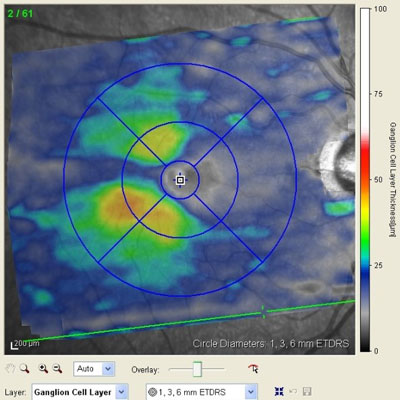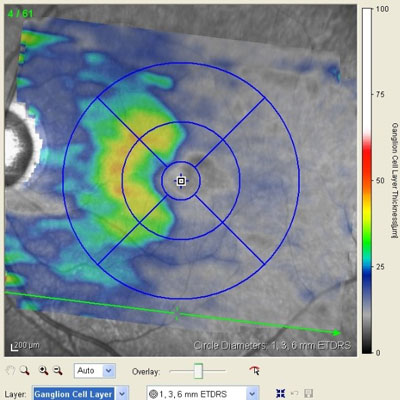BLOG: If my patient has a hemianopia, will there be OCT changes?
Most of us have seen patients with visual field changes from stroke, and we confirm a homonymous hemianopia (HH, or hemianopsia, if you prefer; as far as I can tell they’re synonyms) with automated visual field testing. But could we also confirm it with optical coherence tomography findings?
We know that certain areas of the optic radiations in the cortex are damaged, but do the corresponding retinal ganglion cell (RGC) fibers show thinning?
For years the answer was no. The reasons given were: no evidence of this was seen on fundoscopy or optic nerve evaluation and the nerve degeneration would have to cross over a synapse.
It would make sense that if you sever the posterior optic nerve, the ipsilateral optic nerve head would eventually atrophy. But would it make sense that the corresponding area in the brain would lose density? After all, as we know, the optic nerves become the optic tract, which synapses in the lateral geniculate nucleus (LGN), then travels to the occipital cortex as the optic radiations as separate neurons. Why would the optic radiations atrophy if the optic tract is damaged?
The phenomenon is called trans-synaptic degeneration (TSD), and is the topic we’ll explore this month.
First, some definitions. Recall that anterograde (or ascending, or Wallerian) degeneration of a neuron proceeds posteriorly along the axon that has been separated from its cell body. Say you sever the posterior optic nerve about 2 mm posterior to the globe. Anterograde degeneration is the change in the rest of the optic nerve posterior to the lesion and the optic tracts leading up to the LGN. This happens fast, and in the case of optic nerve damage, changes in the LGN are noticed within 24 hours, and the degeneration is complete within about 7 days.
Retrograde (or descending) degeneration occurs in the opposite direction – in the proximal segment of the axon that remains in contact with the cell body – and takes much longer. In the case of the optic nerve, it takes about 6 to 8 weeks for the RGCs to become unviable. Trans-synaptic degeneration is when a neuron on one side of a synapse degenerates as a consequence of the loss of a neuron on the other side.
There has been past evidence of anterograde trans-synaptic degeneration (ATSD) in the visual system. More than 100 years ago, Cajal described changes in the occipital lobe in blind or one-eyed patients. And there has been evidence of retrograde trans-synaptic degeneration (RTSD) outside the visual system for years; eg, changes in corresponding areas of the brain after limb amputations. But there has never been evidence for RTSD in the visual system.
There were case reports of soldiers sustaining occipital lobe injuries and the developing optic atrophy 3.5 years later, but explanations for the atrophy such as papilledema could not be ruled out. There have been cases of retinal changes in certain cerebral infarctions, but recall that one of the first branches of the middle cerebral artery (MCA) branches is the ophthalmic artery, so an MCA infarction could theoretically cause ocular changes via ischemia, and not necessarily RTSD. It’s also important to rule out the fact that the cause of a visual field defect could be due to damage to the optic tract, not necessarily the radiations, in which case, changes in the eye could simply represent retrograde degeneration. The exact location of the brain injury is important to determine if the degeneration is simply retrograde or truly RTSD.


The first proof of RTSD in the visual system was made in the 21st century with the advent of OCT, when patients with unilateral occipital infarcts (without optic tract involvement, verified by a neuroradiologist) showed retinal nerve fiber layer (RNFL) thinning in the corresponding areas. Later, with the advent of spectral domain OCT, the layers of the retina were able to be segmented out, and the thickness of the ganglion cell layer (GCL) was also found to be significantly atrophied in RTSD. In fact, most studies have shown that the GCL is more sensitive to RTSD than is the RNFL, but the reasons are unclear.
One of the more frequently quoted studies looked at 11 patients with quadrantopias due to occipital cortical disease of varying etiologies. They found that 20 out of 22 eyes showed significant GCL thinning, but RNFL thinning was observed in only 15 out of 22 eyes. The time course of RTSD is variable over the literature but is generally thought to show a logarithmic pattern of relatively fast atrophy (some say 4.4 um/year) within the first 2 years, and then a slow rate after that.
So, what does this mean for our management of these patients? In every study, there was always at least one patient with occipital lobe damage and visual field loss without RTSD (at least observable by OCT), and the reasons why there isn’t 100% association are unclear. But some postulate that patients with less (or no) RTSD have a better opportunity for some visual field recovery, which might provide a real-life clinical use for serial SD-OCT in HH patients. Perhaps these patients have a milder defect and a greater cortical plasticity.
Another important use could be for patients with occipital lobe damage that are unable to sit for visual field testing. While this should not replace formal visual field testing, there certainly could be utility in learning the status of the GCL thickness in patients with (confirmed or suspected) cortical disease.
References:
Cajal S, et al. Histologie du systeme nerveux de l’homme et des verte’bres. Vol 2. Paris: Maloine: 1911.
Millington RS, et al. J Neurol Neurosurg Psychiatry. 2014;85(4):379-386;doi:10.1136/jnnp-2013-306577.
Miller NR, Newman NJ, eds. Walsh and Hoyt’s Clinical Neuro-ophthalmology, 6th ed. Philadelphia: Lippincott, Williams and Wilkins; 2005.
Mitchell JR, et al. J Neuroophthalmol. 2015;35(4):353-359;doi:10.1097/WNO.0000000000000268.
